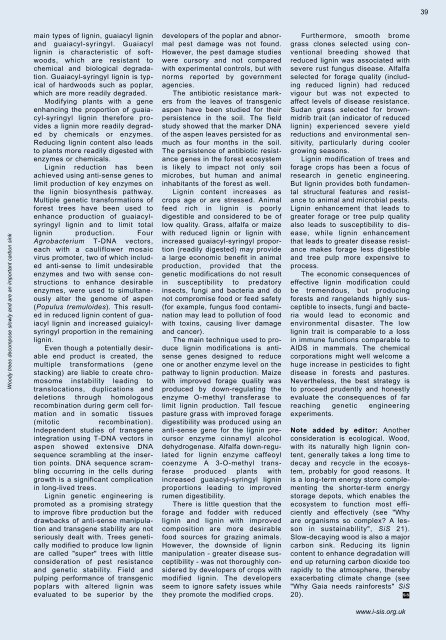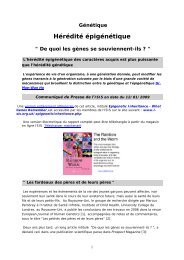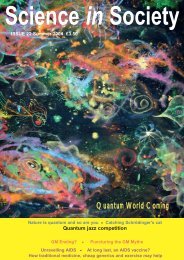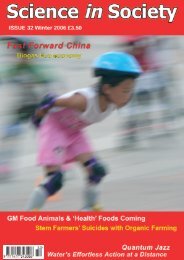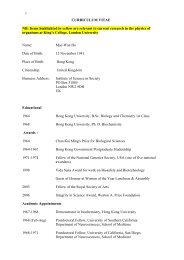Ethiopia goes organic to feed herself - The Institute of Science In ...
Ethiopia goes organic to feed herself - The Institute of Science In ...
Ethiopia goes organic to feed herself - The Institute of Science In ...
You also want an ePaper? Increase the reach of your titles
YUMPU automatically turns print PDFs into web optimized ePapers that Google loves.
39<br />
Woody trees decompose slowly and are an important carbon sink<br />
main types <strong>of</strong> lignin, guaiacyl lignin<br />
and guaiacyl-syringyl. Guaiacyl<br />
lignin is characteristic <strong>of</strong> s<strong>of</strong>twoods,<br />
which are resistant <strong>to</strong><br />
chemical and biological degradation.<br />
Guaiacyl-syringyl lignin is typical<br />
<strong>of</strong> hardwoods such as poplar,<br />
which are more readily degraded.<br />
Modifying plants with a gene<br />
enhancing the proportion <strong>of</strong> guaiacyl-syringyl<br />
lignin therefore provides<br />
a lignin more readily degraded<br />
by chemicals or enzymes.<br />
Reducing lignin content also leads<br />
<strong>to</strong> plants more readily digested with<br />
enzymes or chemicals.<br />
Lignin reduction has been<br />
achieved using anti-sense genes <strong>to</strong><br />
limit production <strong>of</strong> key enzymes on<br />
the lignin biosynthesis pathway.<br />
Multiple genetic transformations <strong>of</strong><br />
forest trees have been used <strong>to</strong><br />
enhance production <strong>of</strong> guaiacylsyringyl<br />
lignin and <strong>to</strong> limit <strong>to</strong>tal<br />
lignin production. Four<br />
Agrobacterium T-DNA vec<strong>to</strong>rs,<br />
each with a cauliflower mosaic<br />
virus promoter, two <strong>of</strong> which included<br />
anti-sense <strong>to</strong> limit undesirable<br />
enzymes and two with sense constructions<br />
<strong>to</strong> enhance desirable<br />
enzymes, were used <strong>to</strong> simultaneously<br />
alter the genome <strong>of</strong> aspen<br />
(Populus tremuloides). This resulted<br />
in reduced lignin content <strong>of</strong> guaiacyl<br />
lignin and increased guiaicylsyringyl<br />
proportion in the remaining<br />
lignin.<br />
Even though a potentially desirable<br />
end product is created, the<br />
multiple transformations (gene<br />
stacking) are liable <strong>to</strong> create chromosome<br />
instability leading <strong>to</strong><br />
translocations, duplications and<br />
deletions through homologous<br />
recombination during germ cell formation<br />
and in somatic tissues<br />
(mi<strong>to</strong>tic<br />
recombination).<br />
<strong>In</strong>dependent studies <strong>of</strong> transgene<br />
integration using T-DNA vec<strong>to</strong>rs in<br />
aspen showed extensive DNA<br />
sequence scrambling at the insertion<br />
points. DNA sequence scrambling<br />
occurring in the cells during<br />
growth is a significant complication<br />
in long-lived trees.<br />
Lignin genetic engineering is<br />
promoted as a promising strategy<br />
<strong>to</strong> improve fibre production but the<br />
drawbacks <strong>of</strong> anti-sense manipulation<br />
and transgene stability are not<br />
seriously dealt with. Trees genetically<br />
modified <strong>to</strong> produce low lignin<br />
are called "super" trees with little<br />
consideration <strong>of</strong> pest resistance<br />
and genetic stability. Field and<br />
pulping performance <strong>of</strong> transgenic<br />
poplars with altered lignin was<br />
evaluated <strong>to</strong> be superior by the<br />
developers <strong>of</strong> the poplar and abnormal<br />
pest damage was not found.<br />
However, the pest damage studies<br />
were cursory and not compared<br />
with experimental controls, but with<br />
norms reported by government<br />
agencies.<br />
<strong>The</strong> antibiotic resistance markers<br />
from the leaves <strong>of</strong> transgenic<br />
aspen have been studied for their<br />
persistence in the soil. <strong>The</strong> field<br />
study showed that the marker DNA<br />
<strong>of</strong> the aspen leaves persisted for as<br />
much as four months in the soil.<br />
<strong>The</strong> persistence <strong>of</strong> antibiotic resistance<br />
genes in the forest ecosystem<br />
is likely <strong>to</strong> impact not only soil<br />
microbes, but human and animal<br />
inhabitants <strong>of</strong> the forest as well.<br />
Lignin content increases as<br />
crops age or are stressed. Animal<br />
<strong>feed</strong> rich in lignin is poorly<br />
digestible and considered <strong>to</strong> be <strong>of</strong><br />
low quality. Grass, alfalfa or maize<br />
with reduced lignin or lignin with<br />
increased guaiacyl-syringyl proportion<br />
(readily digested) may provide<br />
a large economic benefit in animal<br />
production, provided that the<br />
genetic modifications do not result<br />
in susceptibility <strong>to</strong> preda<strong>to</strong>ry<br />
insects, fungi and bacteria and do<br />
not compromise food or <strong>feed</strong> safety<br />
(for example, fungus food contamination<br />
may lead <strong>to</strong> pollution <strong>of</strong> food<br />
with <strong>to</strong>xins, causing liver damage<br />
and cancer).<br />
<strong>The</strong> main technique used <strong>to</strong> produce<br />
lignin modifications is antisense<br />
genes designed <strong>to</strong> reduce<br />
one or another enzyme level on the<br />
pathway <strong>to</strong> lignin production. Maize<br />
with improved forage quality was<br />
produced by down-regulating the<br />
enzyme O-methyl transferase <strong>to</strong><br />
limit lignin production. Tall fescue<br />
pasture grass with improved forage<br />
digestibility was produced using an<br />
anti-sense gene for the lignin precursor<br />
enzyme cinnamyl alcohol<br />
dehydrogenase. Alfalfa down-regulated<br />
for lignin enzyme caffeoyl<br />
coenzyme A 3-O-methyl transferase<br />
produced plants with<br />
increased guaiacyl-syringyl lignin<br />
proportions leading <strong>to</strong> improved<br />
rumen digestibility.<br />
<strong>The</strong>re is little question that the<br />
forage and fodder with reduced<br />
lignin and lignin with improved<br />
composition are more desirable<br />
food sources for grazing animals.<br />
However, the downside <strong>of</strong> lignin<br />
manipulation - greater disease susceptibility<br />
- was not thoroughly considered<br />
by developers <strong>of</strong> crops with<br />
modified lignin. <strong>The</strong> developers<br />
seem <strong>to</strong> ignore safety issues while<br />
they promote the modified crops.<br />
Furthermore, smooth brome<br />
grass clones selected using conventional<br />
breeding showed that<br />
reduced lignin was associated with<br />
severe rust fungus disease. Alfalfa<br />
selected for forage quality (including<br />
reduced lignin) had reduced<br />
vigour but was not expected <strong>to</strong><br />
affect levels <strong>of</strong> disease resistance.<br />
Sudan grass selected for brownmidrib<br />
trait (an indica<strong>to</strong>r <strong>of</strong> reduced<br />
lignin) experienced severe yield<br />
reductions and environmental sensitivity,<br />
particularly during cooler<br />
growing seasons.<br />
Lignin modification <strong>of</strong> trees and<br />
forage crops has been a focus <strong>of</strong><br />
research in genetic engineering.<br />
But lignin provides both fundamental<br />
structural features and resistance<br />
<strong>to</strong> animal and microbial pests.<br />
Lignin enhancement that leads <strong>to</strong><br />
greater forage or tree pulp quality<br />
also leads <strong>to</strong> susceptibility <strong>to</strong> disease,<br />
while lignin enhancement<br />
that leads <strong>to</strong> greater disease resistance<br />
makes forage less digestible<br />
and tree pulp more expensive <strong>to</strong><br />
process.<br />
<strong>The</strong> economic consequences <strong>of</strong><br />
effective lignin modification could<br />
be tremendous, but producing<br />
forests and rangelands highly susceptible<br />
<strong>to</strong> insects, fungi and bacteria<br />
would lead <strong>to</strong> economic and<br />
environmental disaster. <strong>The</strong> low<br />
lignin trait is comparable <strong>to</strong> a loss<br />
in immune functions comparable <strong>to</strong><br />
AIDS in mammals. <strong>The</strong> chemical<br />
corporations might well welcome a<br />
huge increase in pesticides <strong>to</strong> fight<br />
disease in forests and pastures.<br />
Nevertheless, the best strategy is<br />
<strong>to</strong> proceed prudently and honestly<br />
evaluate the consequences <strong>of</strong> far<br />
reaching genetic engineering<br />
experiments.<br />
Note added by edi<strong>to</strong>r: Another<br />
consideration is ecological. Wood,<br />
with its naturally high lignin content,<br />
generally takes a long time <strong>to</strong><br />
decay and recycle in the ecosystem,<br />
probably for good reasons. It<br />
is a long-term energy s<strong>to</strong>re complementing<br />
the shorter-term energy<br />
s<strong>to</strong>rage depots, which enables the<br />
ecosystem <strong>to</strong> function most efficiently<br />
and effectively (see "Why<br />
are organisms so complex? A lesson<br />
in sustainability", SiS 21).<br />
Slow-decaying wood is also a major<br />
carbon sink. Reducing its lignin<br />
content <strong>to</strong> enhance degradation will<br />
end up returning carbon dioxide <strong>to</strong>o<br />
rapidly <strong>to</strong> the atmosphere, thereby<br />
exacerbating climate change (see<br />
"Why Gaia needs rainforests" SiS<br />
20). SiS<br />
www.i-sis.org.uk


